Beach-ridge architecture constrained by beach topography and ground-penetrating radar, Itilleq (Laksebugt), south-west Disko, Greenland – implications for sea-level reconstructions.
IF 1
4区 地球科学
Q2 Earth and Planetary Sciences
引用次数: 4
Abstract
Detailed topographic data and high-resolution ground-penetrating radar (GPR) reflection data are presented from the present-day beach and across successive raised beach ridges at Itilleq, south-west Disko, West Greenland. In the western part of the study area, the present low-tide level is well defined by an abrupt change in sediment grain size between the sandy foreshore and the upper shoreface that is characterised by frequently occurring large clasts. The main parts of both fine and large clasts appear to be locally derived. Seaward-dipping reflections form downlap points, which are clearly identified in all beach-ridge GPR profiles. Most of them are located at the boundary between a unit with reflection characteristics representing palaeo-foreshore deposits and a deeper and more complex radar unit characterised by diffractions; the deeper unit is not penetrated to large depths by the GPR signals. Based on observations of the active shoreface regime, large clasts are interpreted to give rise to scattering observed near the top of the deeper radar unit. We regard the downlap points located at this radar boundary as markers of palaeo-low-tide levels. In some places, scattering hyperbolas are more pronounced and frequent than in others, suggesting differences in the occurrence of large boulders.受海滩地形和探地雷达约束的海滩脊建筑,格陵兰岛迪斯科西南部的Itilleq (Laksebugt) -对海平面重建的影响。
详细的地形数据和高分辨率探地雷达(GPR)反射数据来自现在的海滩和西格陵兰岛迪斯科西南部的Itilleq连续凸起的海滩山脊。在研究区西部,目前的低潮位是由砂质前滨与上滨面之间的沉积物粒度突变所确定的,其特征是频繁出现大型碎屑。细碎屑和大碎屑的主要部分似乎都是局部衍生的。向海倾斜的反射形成下陷点,这在所有海滩-山脊探地雷达剖面中都能清楚地识别出来。它们大多位于具有反射特征的古前滨沉积单元与具有衍射特征的更深、更复杂的雷达单元之间的边界;探地雷达信号无法穿透较深的单元。根据对活跃的岸面状态的观测,大的碎屑被解释为引起在较深雷达单元顶部附近观测到的散射。我们把位于该雷达边界的沉降点作为古低潮水位的标志。在一些地方,散射双曲线比其他地方更明显、更频繁,这表明大块巨石的出现情况有所不同。
本文章由计算机程序翻译,如有差异,请以英文原文为准。
求助全文
约1分钟内获得全文
求助全文
来源期刊

Bulletin of the Geological Society of Denmark
GEOSCIENCES, MULTIDISCIPLINARY-
CiteScore
2.80
自引率
16.70%
发文量
28
审稿时长
>12 weeks
期刊介绍:
The Bulletin publishes contributions of international interest in all fields of geological sciences on results of new work on material from Denmark, the Faroes and Greenland. Contributions based on other material may also be submitted to the Bulletin if the subject is of relevance for the geology of the area of primary interest.
 求助内容:
求助内容: 应助结果提醒方式:
应助结果提醒方式:


